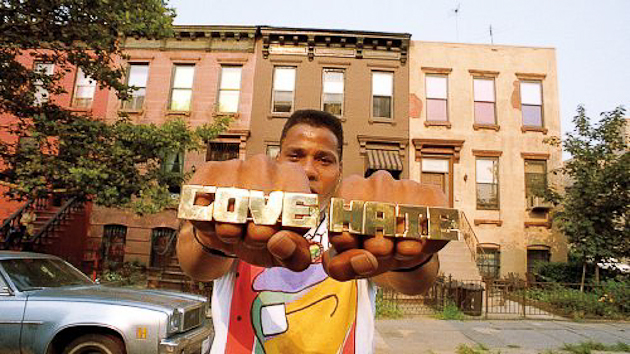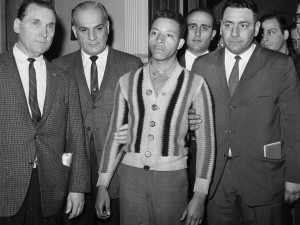 Twenty minutes into Vincente Minnelli’s 1952 classic The Bad & The Beautiful, Kirk Douglas – portraying a budding Hollywood producer – poses the question, “What scares the human race more than any other single thing?” While the real answer is the unknown, Douglas presupposes the answer to be darkness. And he’s right, at least as it pertains to cinema. To deprive people of what they’ve been conditioned to expect is to prey upon their insecurity. To do so in a pitch-black theater is to induce a certain level of hysteria.
Twenty minutes into Vincente Minnelli’s 1952 classic The Bad & The Beautiful, Kirk Douglas – portraying a budding Hollywood producer – poses the question, “What scares the human race more than any other single thing?” While the real answer is the unknown, Douglas presupposes the answer to be darkness. And he’s right, at least as it pertains to cinema. To deprive people of what they’ve been conditioned to expect is to prey upon their insecurity. To do so in a pitch-black theater is to induce a certain level of hysteria.
That said, it takes a master manipulator to transform all of that fear into a story. In the majority of cases – at least the well-documented ones – any production’s reliance on ancillary effects to create the illusion of unspeakable evil is largely a matter of necessity. Forced into a corner, the crew pushes creativity to its limit, using visual devices and cues to conjure what cannot be shown. Be it a matter of sheer cunning or happenstance, these six horror classics changed the genre for the better, proving in the process that there is no threat more potent than the one inside our heads:
1. The Blair Witch Project (1999). At the time The Blair Witch Project was released, found-footage wasn’t even a sub-genre. And that worked to the movie’s advantage. America hadn’t fully immersed itself inside the digital culture, which meant an independent movie that marketed itself as “a true story” could fly under the radar long enough to sprout wings. Could it be real? This grainy footage of three film students unfolding up on-screen? A tight-knit trio, lost in the woods, hunting down some urban legend that was closing in around them? Blair Witch‘s no-frills production all but begged the question: If it wasn’t real, why shoot a motion picture like this? The answer, of course, resided in a major lack of financing (the initial budget was set just under $600,000). Blair Witch would go on to gross $250 million worldwide, inspiring a grassroots revolution in the process. Cloverdale, V/H/S and Paranormal Activity (among others) … all built off of a similar formula. Draw the audience in, funnel through some rising beats, then lower the boom with 30 seconds
left to go.
2. Friday the 13th (1980). Friday the 13th somehow managed to turn a one-off cheesy slasher film into a multi-decade franchise, this despite an original screenplay which barely featured any draw. Director Sean S. Cunningham cashed in on the idea that you never knew when or where the tension would heighten. Will it happen when she steps outside? When she dips her toes into the water? The original Friday the 13th, inspired by John Carpenter’s Halloween and produced on a $550,000 budget, was much more about the sudden gasp than it was about some serial killer. As a matter of fact, you almost never saw any killer throughout the original. It wasn’t until a year later, when that hockey mask appeared, worn by a second-generation pyscho who was apparently undead, that the franchise made its turn toward one character. Having reached the point of reboot (along with several features on this list), perhaps it’s time to put that Voorhees kid to sleep.
3. Halloween (1978). Halloween has been discussed via this website before – the ingenuity, the $2 mask, the bare-bones crew, the terrifying silence. In the early days, the only thing Halloween had going for it was John Carpenter, a man who built the story, rigged the set, wrote the music, and hired Jamie-Lee Curtis. What Carpenter lacked was sufficient funding (Halloween‘s initial budget was only $300,000). As a result, Carpenter hired Tony Moran, an old college buddy, to play Michael Myers at a cost of $25 per day. Halloween would go on to inspire an entire decade’s worth of slasher films, proving – yet again – that great movies could be made on miniscule budgets. Nearly 40 long years later, Halloween is still the only movie in demand throughout October. This is welcome news for Carpenter, who signed a back-end deal worth 10%.
4. Jaws (1975). Most people are familiar with the legend: faced with a malfunctioning mechanical shark, Steven Spielberg and his unit were forced to develop an impromptu system for suggesting that the shark was there.They did this by employing a variety of techniques, chief among them a visual cue involving floating yellow barrels, accompanied by the two most memorable piano notes in cinematic history. Those notes – the brainchild of John Williams – were played at varying speeds to identify how near or far the shark was from its prey. Under no circumstances were they used to bamboozle the audience. That is to say, if the music wasn’t playing, the shark could not be there (notice the eery silence throughout the “cardboard fin” scene). For the first full hour of the movie, Spielberg seems consumed with story, all the while reinforcing the presence of some evil out at sea. By the time that grisly beast appears, Spielberg’s audience is fully vested. As a result, viewers wind up rooting for The Orca all the more.
5. Psycho (1960). The shower scene, the use of chocolate as a surrogate for blood, killing off your main character, keeping the identity of your killer a guarded secret … the back story of Psycho is so shrouded in mystique as to rival Coppola’s Godfather, or even Spielberg’s Jaws. Initially rejected by Paramount, Alfred Hitchcock took the reins, agreeing to shoot the film in black and white, hire a television production crew, finance it himself and bypass his director’s fee (in lieu of a back-end deal). Hitchcock was coming off a rough patch, his genius reconsidered, and the only thing that would restore the studio’s faith was a major coup de grace. And so Hitchcock obliged, working off a back-lot set inspired by Edward Hopper’s House By The Railroad. Psycho‘s initial budget: $800,000. Its box-office take: $60 million. Despite middling reviews, Hitchcock’s movie was also nominated for four Academy Awards, none of which it won.
6. The War of the Worlds (1938). “At the time that you were giving this role, were you aware that terror was going on throughout the nation?” So said a reporter to Orson Welles less than 24 hours after his original CBS broadcast of War of The Worlds. Much like Jaws, Psycho and Friday the 13th, Welles was working off of someone else’s source material. Unlike those others, Welles nearly caused an interplanetary incident. Radio bulletins describing an alien invasion, each of them relayed during a period when there was no easy way of confirming. People were fleeing their houses, flocking to churches, sucked in by a ruse that couldn’t have existed on TV. War of The Worlds required one minor troupe, an intimate studio, zero visuals and a captive audience. Given the fallout, Welles’ broadcast remains a primary example of how to manipulate the fold.


